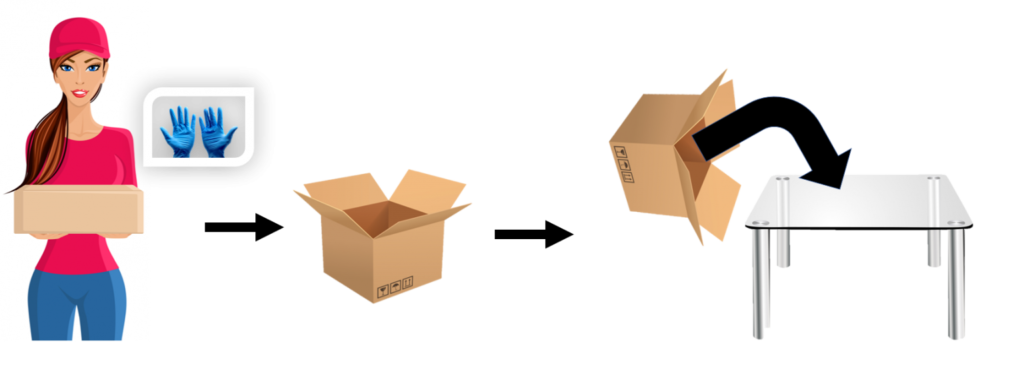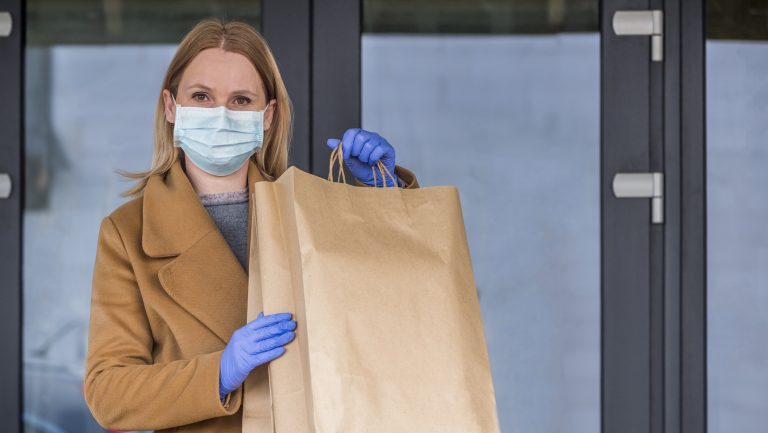
Safe & Simple Strategies for Gloves, Face Masks, and Hand Washing
Follow this Advice and Stay Safe!
Are You Using Personal Protective Equipment (PPE) Correctly?
Personal protective equipment (PPE) comes in many shapes and forms. Some items are unique and specialized to certain fields, while others are used for generic purpose. From the former category are beekeepers’ netted veil face masks and firefighters’ thermal-protective gear, both highly specialized. [1] Goggles (eye protection), respirators or face masks (respiratory protection), latex or nitrile gloves (skin/hand protection) are in the latter group: their wide-ranging usage spans from healthcare offices to nail salons to factories to auto shops. Individuals who regularly utilize PPE for their jobs, sports, or hobbies typically learn proper handling skills from mentors.
With COVID-19, some of these items – namely masks and gloves – are being made use of by the general population, with little instruction. This blog will delve into some of the dos and don’ts of gloves and face masks amidst the global pandemic.
Gloves
Many experts advise wearing gloves in healthcare settings and also when sanitizing our homes. [2] Outside of those scenarios, their use may actually provide a false sense of security and even lead to increased cross-contamination or exposure.

If used to touch “outside/contaminated” surfaces, gloves may subsequently contact “indoor/uncontaminated” ones, and thus spread the virus particles to these new areas. This is an enormous problem because it has been shown that surfaces can harbor those dangerous particles for hours or days.
In most cases, frequent hand washing will almost always be superior to wearing gloves!
Hands have a tendency to want to be washed when they *feel* dirty. If you touch something dirty or sticky, your hands’ tactile sense will discern an unpleasant feeling. It’s subtle, yes, but that sensation does not exist when you wear gloves, which makes it easy to go from place to place, unbeknownst of contamination.
There are two main instances in which gloves are beneficial for the general population:
1) To touch dirty objects. Your gloves MUST be discarded immediately after.
And,
2) Times when hand washing is not directly available. AVOID touching your face area. It’s a pastime humans seem to subconsciously enjoy very much, but rubbing your nose with dirty gloves defeats the entire purpose of protecting yourself.

To the first point, using gloves to handle a gas pump or an ATM is a great idea. Considering many banks’ in-person services are currently suspended, ATMs have become high traffic areas. It is best to use gloves to touch the buttons on the machine and discard them immediately after. Similarly, use the gloves to pump your gas and them THROW THEM AWAY before returning to your car. We expand on this topic more later in the post.
The point is that gloves are not a panacea.
*Concept: Gloves should contact “dirty” objects (things others are potentially touching) and be removed before touching “clean” objects (things others are not touching, such as the interior of your car).
Face Masks
Many citizens of the world have grown accustomed to the daily use of face masks. [3] However, their suggested frequent use is new among the general American population. The current recommendation advises cloth face coverings in places where social distancing is not possible (grocery stores, pharmacies, etc.). The primary purpose of this precaution is to reduce the spread of viral particles, especially among asymptomatic carriers. [4] Secondarily, these face masks may reduce the amount of inadvertent face-touching in public places.

Cloth face coverings are not the same as medical respirators and face masks. We must reserve those for medical professionals who are on the COVID-19 front lines providing preventive or urgent care.
How Do I Open Packages, Fill My Gas Tank, and Shop for Groceries Safely?
Let’s examine certain common situations we are all encountering right now and give some advice about when you should be handwashing vs. wearing gloves. Let’s look at how to properly approach everyday tasks.
What’s the best way to open packages?
Now more than ever, people are ordering items from online companies and getting them shipped to their homes. Delivery drivers are leaving packages on doorsteps to minimize the virus’ spread. However, we have no idea who else handled our boxes and what precautions they took. We do know that, for the most part, COVID stays on paper products like cardboard between one and four days. If you want more information about this, reference the article “How Long Does the Coronavirus Live on Surfaces?“
I grab a pair of gloves and my scissors and then I go outside to the package. From this moment, I only touch the outside of the box and the scissors. I open the box and usually I have someone grab its contents (a new pair of shoes) with their clean hands while I hold the box flaps open. If nobody is around to help, I carefully dump my shiny new shoes onto a clean towel, blanket, table, or couch, so nothing breaks.
We do things similarly in the surgical OR: if a specific tool is needed, that is how an outside helper gets it inside to someone in the sterile area.

Back to my Amazon package. As soon as the contents are out of the box (remember that we are not touching the materials with our gloved hands), we’re done. Discard the packaging and then remove the gloves using the proper technique in this video. Try keeping doors open in the areas you need to walk through to get to your sink so you can avoid touching doorknobs with dirty hands. Also, remember to wash your scissors with soap.

How can I safely fill up at the gas station?
If you can, take a couple of pairs of gloves with you. Before touching the pad at the gas station, put them on.
*Concept: Use your washed hands for areas that you touch often and try to clean those spots regularly with Lysol or alcohol. If you contact an area frequently, sanitize it frequently.
Your gas cap is something you’ll only access a few times, so instead of cleaning it, use gloves. Remember to remove them right after.

(A) Wear gloves to touch keypad, use credit card, and (B) fill gas. (C) Remove gloves prior to opening car door.
Envision getting out of your car, putting your gloves on, touching the number pad, inserting your credit card, opening the tank, filling it, closing back up, getting your receipt, and then, finally, discarding your gloves.
Remember to take off your gloves and throw them out using the proper technique.
At this point, you can use your bare hands to open the door handle and get in your car. Keep in mind that if you mess up, it is not a huge deal – we all forget things sometimes.
But what if I enter my car and forget to take my gloves off?
Try to remember everything you touched and sanitize it thoroughly. To avoid headaches, do your best to always TAKE YOUR GLOVES OFF BEFORE YOU TOUCH YOUR CAR DOOR HANDLE.
How about grocery shopping?
Going to the grocery store alone:
To execute this task cleanly, you will need to prepare in advance. One important thing to consider is that you will likely be using your credit card. I keep a napkin in my pocket or keep my card in a sandwich bag to minimize its contact with anything else.
*Concept: Use a napkin or sandwich bag when touching any surface of a credit card.
Ideally, you drive to the grocery store, lock your car, and then put your gloves and mask on. Complete all the shopping, touching of objects, and cart pushing with your PPE on. The only time that you need to worry is when you are checking out. Handle your credit card with your napkin. Now that you paid for your groceries, head back to your car. Up until now, you’ve handled your car keys with relatively clean hands. We want to maintain this. Here, I recommend taking off one glove to unlock the car (throw the glove away immediately of course). Then, use your remaining gloved hand to load the groceries into the trunk of your vehicle.

Let’s say, for instance, that you have some heavy items that require both of your hands for lifting. What you can do in that situation is to be prepared! Place a bottle of hand sanitizer in the trunk of your car. As you approach your vehicle with your hands still gloved after grocery shopping, you will take off both gloves, unlock the car, and then unload all groceries. Apply sanitizer when you’re done and you’re good to go.
Upon arriving at your home, find an intermediate point to place your groceries and use that area to wipe down the surface of your grocery store items and any other personal items with an alcohol-based solution. Remember to give your keys, wallet, and credit card a quick wipe down. Be sure to avoid doing anything that could prevent your credit-card from working (like applying alcohol to the swiping strip on the back).
Going to the grocery store with a partner:
There are a couple of different ways to go to the grocery store with a partner. I believe it is efficient to have both people put on gloves right before entering the store. Designate Person A to the cart, objects (like door handles), and credit card or money handling. Assign Person B to the handling of any food items. Person A loads the groceries into the car and subsequently to the intermediate zone previously touched on. Person B can sanitize items with a water-alcohol based solution and load them into the fridge/cabinets. You can trade positions in this last step. If Person B unloads the groceries, then Person A sanitizes.

Conclusion
The COVID-19 pandemic is an unprecedented and unique circumstance that we are all learning to come to grips with. Every day, there is new information. All we can do is try to stay on top of it and stay as safe as possible until the situation eases. Better handwashing practices and optimal utilization of gloves and face masks slow the spread and thus benefit the general population as a whole.
By no means are my methods the only ways to handle things. I am here to open up the discussion for strategies that are safe and practical!
How are you executing these same daily tasks?
What are some other tasks you’ve learned to accomplish while maintaining a high standard of sanitation?
For those living in more metropolitan or rural areas, how do your strategies change?
References
- “Beekeeping Equipment.” MAAREC, agdev.anr.udel.edu/maarec/beginning-beekeeping-2/beekeeping-equipment/.
- “Healthcare Providers.” Centers for Disease Control and Prevention, Centers for Disease Control and Prevention, 31 Jan. 2020, www.cdc.gov/handhygiene/providers/index.html.
- Wong, Tessa. “Coronavirus: Why Some Countries Wear Face Masks and Others Don’t.” BBC News, BBC, 31 Mar. 2020, www.bbc.com/news/world-52015486.
- “Recommendation Regarding the Use of Cloth Face Coverings.” Centers for Disease Control and Prevention, Centers for Disease Control and Prevention, 3 Apr. 2020, www.cdc.gov/coronavirus/2019-ncov/prevent-getting-sick/cloth-face-cover.html.
Contributed By

SOHAIL MERCHANT , Medical Doctor (M.D.); Research Fellow at Lumen Foundation Artificial Intelligence Division – Miami, FL


0 comment